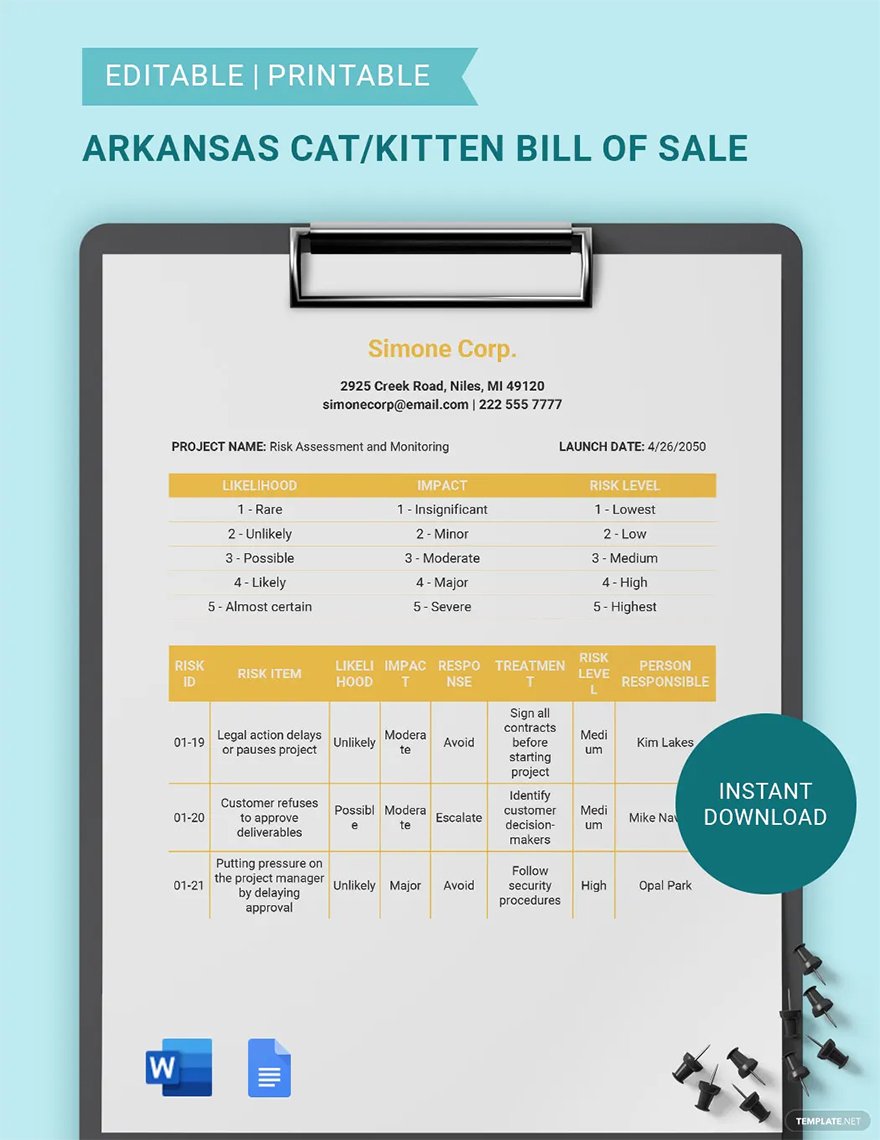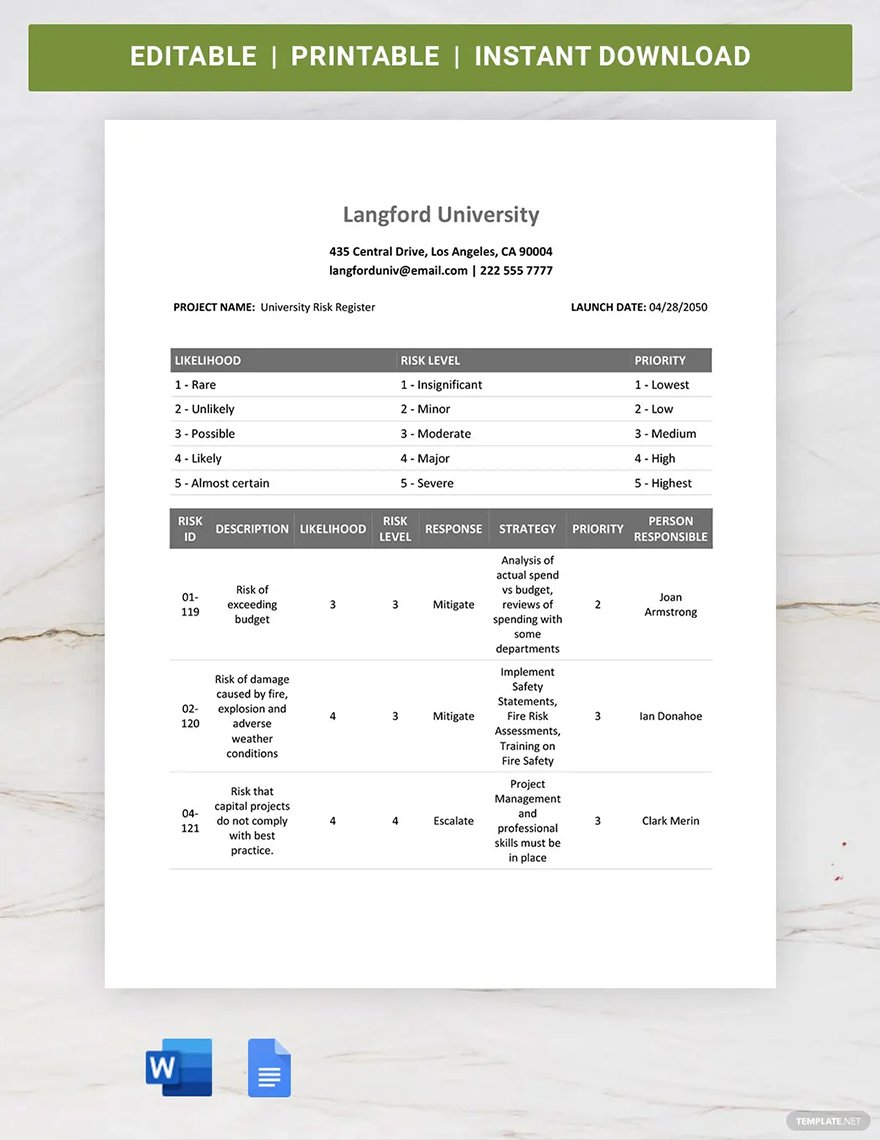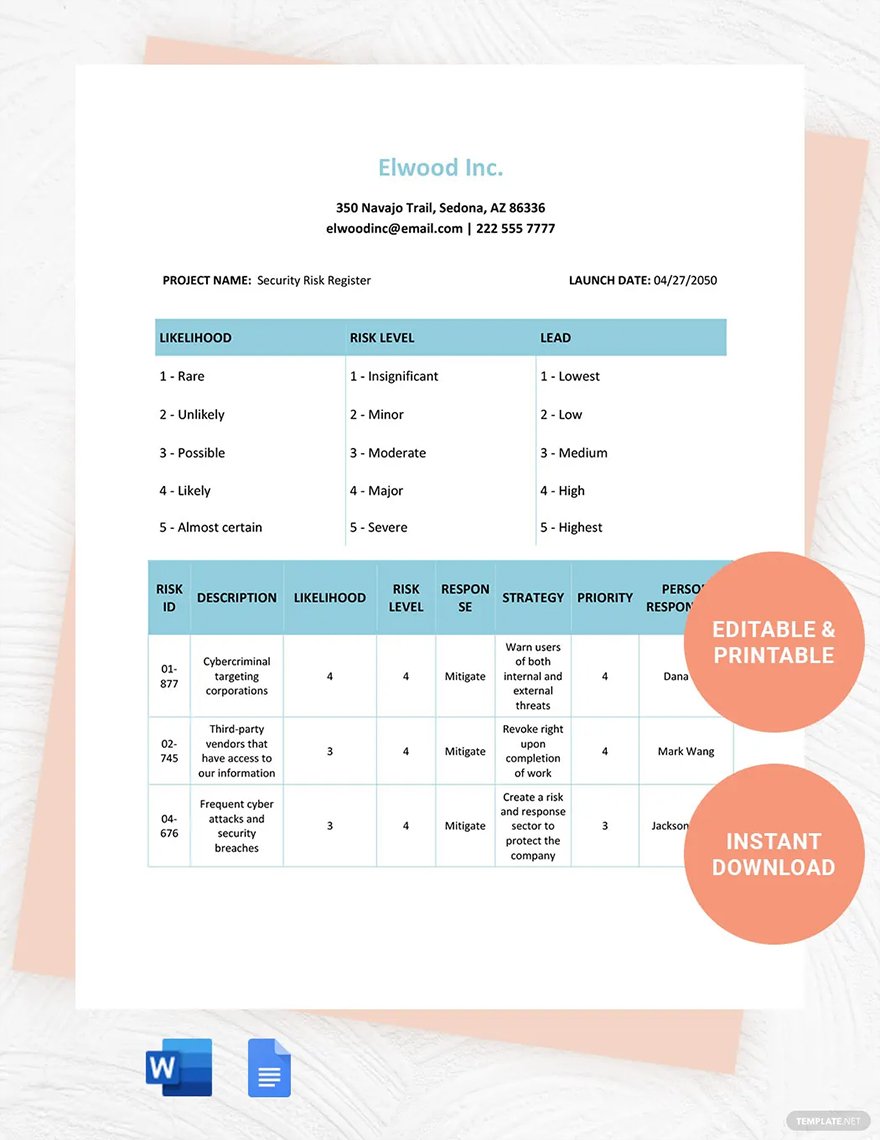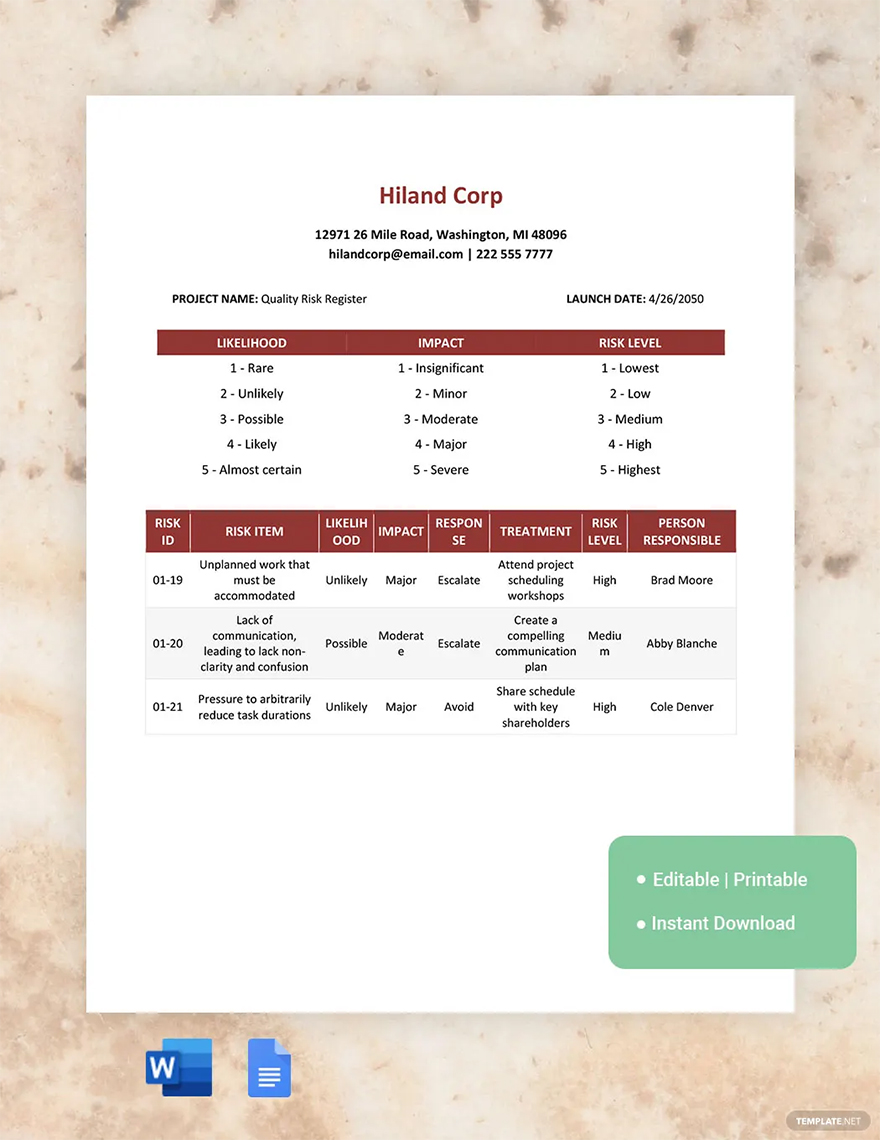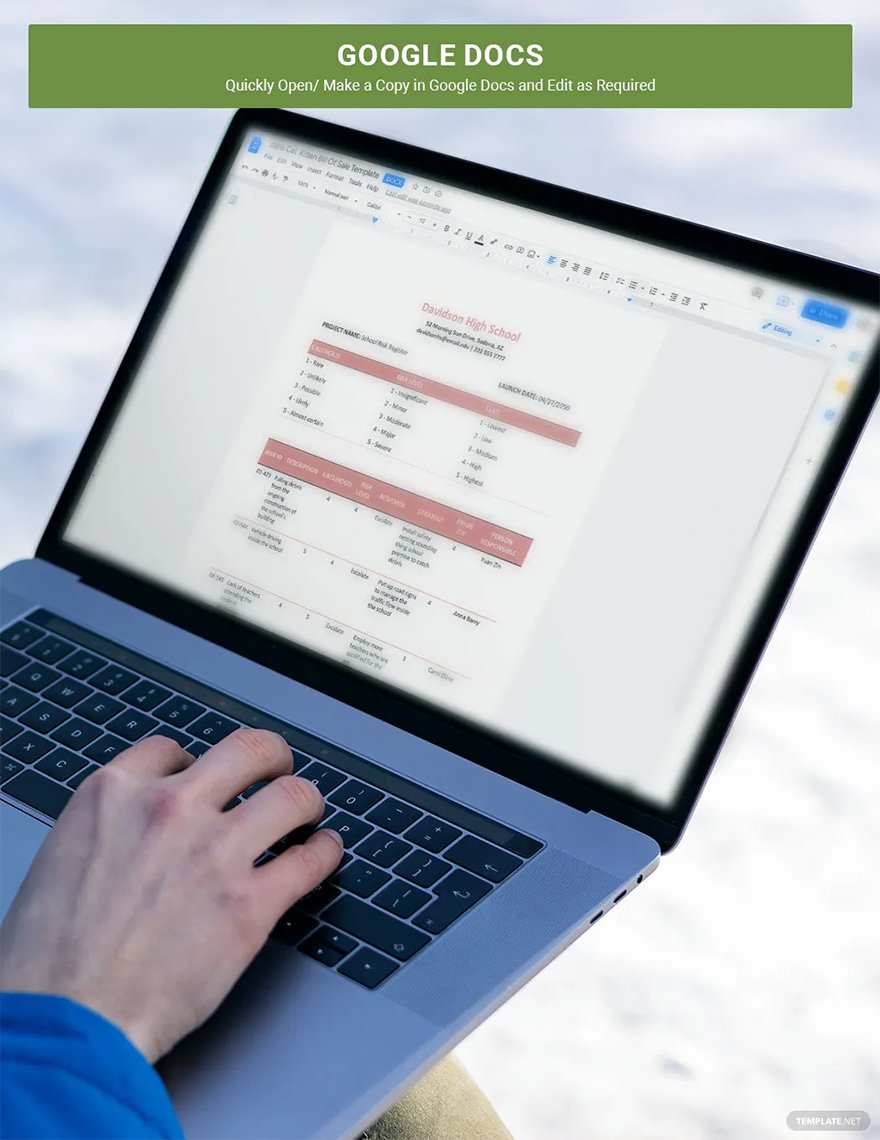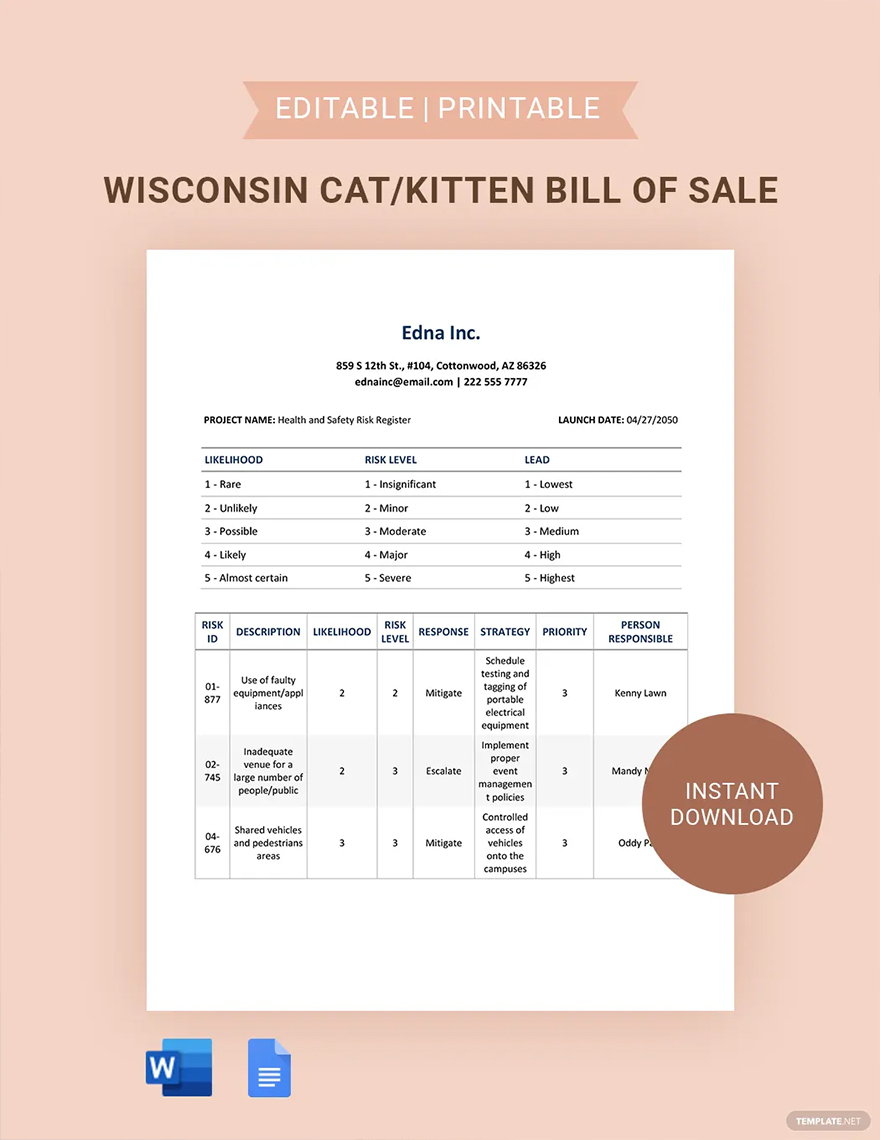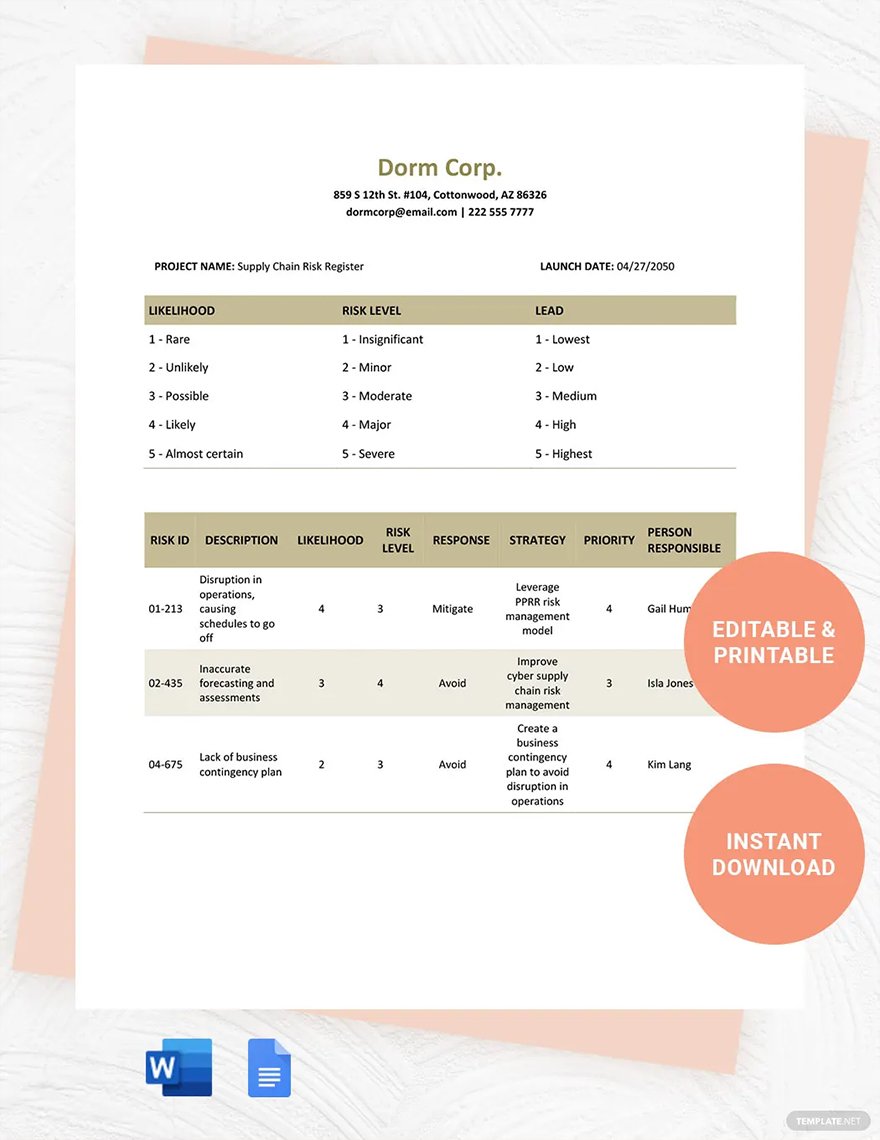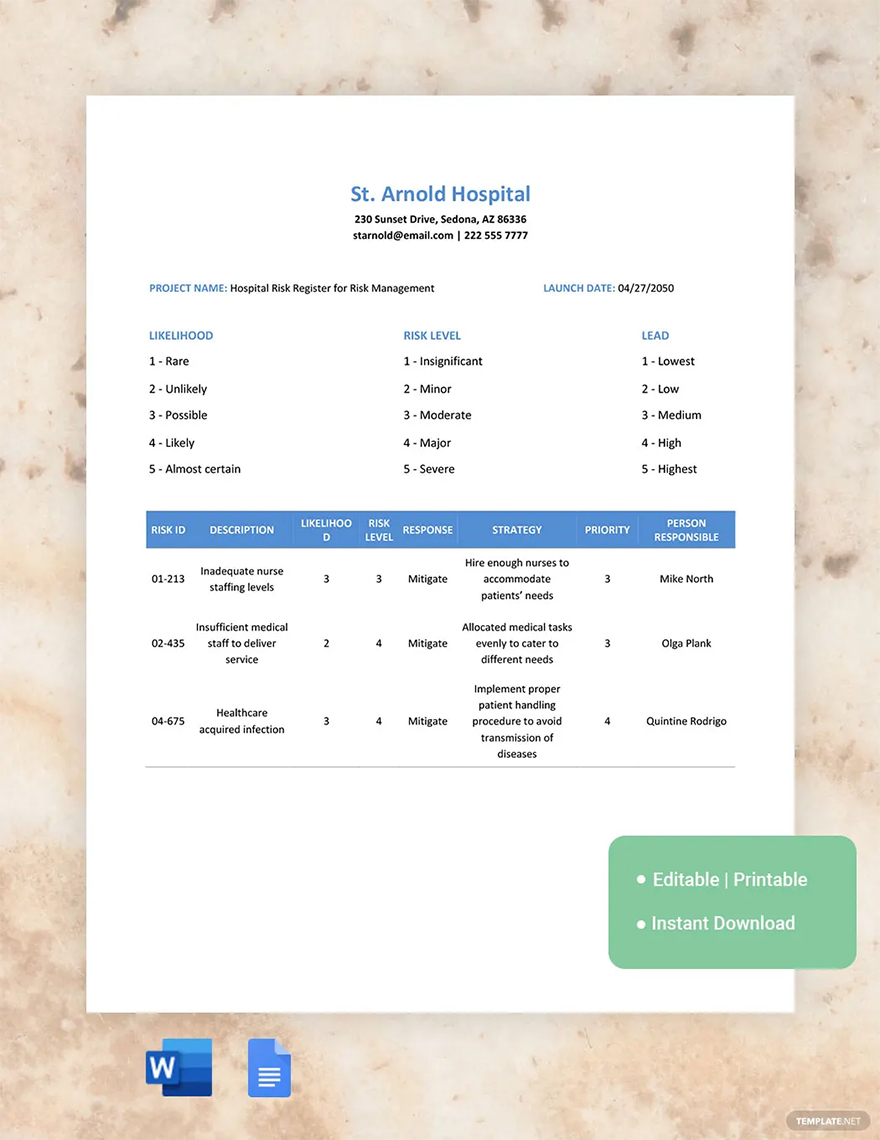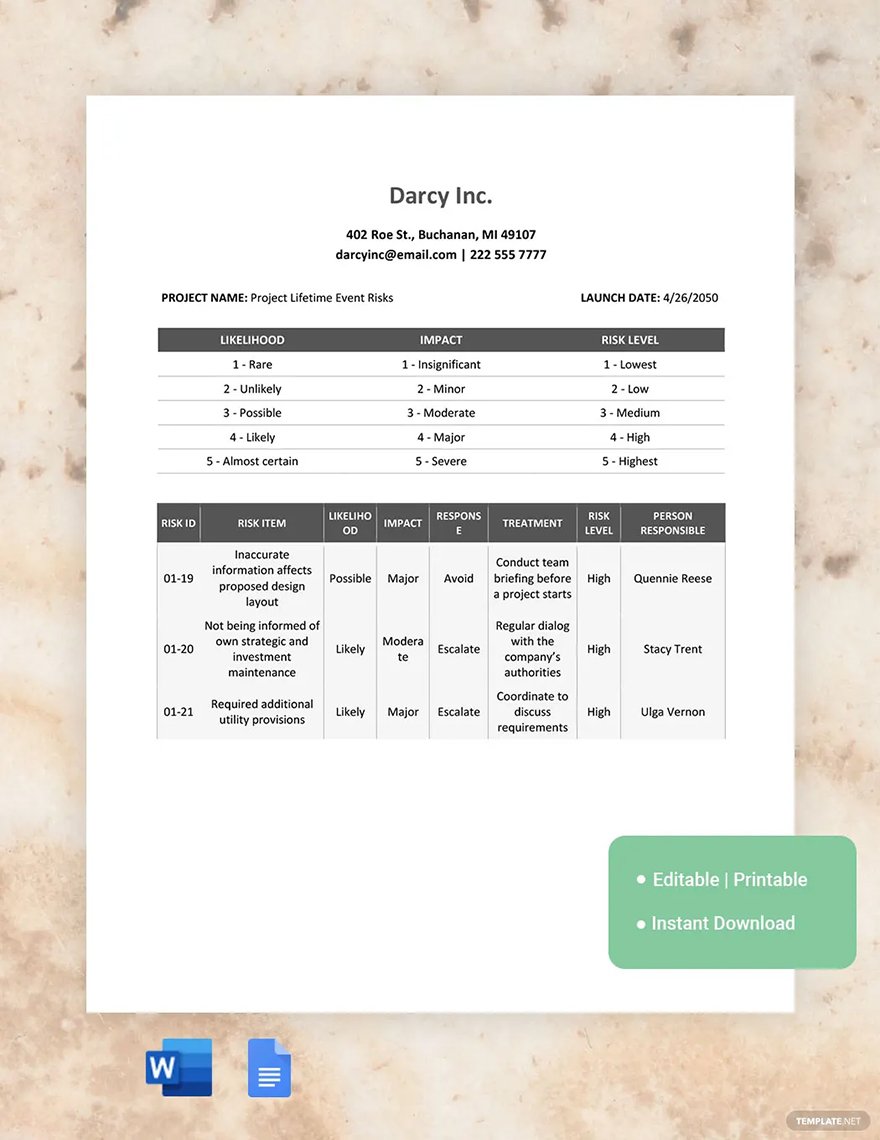Table of Contents
- Risk Register Definition & Meaning
- What Is a Risk Register?
- 10 Types of Risk Register
- Risk Register Uses, Purpose, Importance
- What’s in a Risk Register? Parts?
- How To Design A Risk Register?
- Risk Register vs. Risk Assessment
- What’s the Difference Between Risk Register, Matrix, and Report?
- Risk Register Sizes
- Risk Register Ideas & Examples
- FAQs
Risk Register
Risk registers are business documents that organizations use to track and identify risks and are essential tools in project management for different industries. Many companies utilize tables or charts to organize general and additional information about identified risks in various departments and teams.
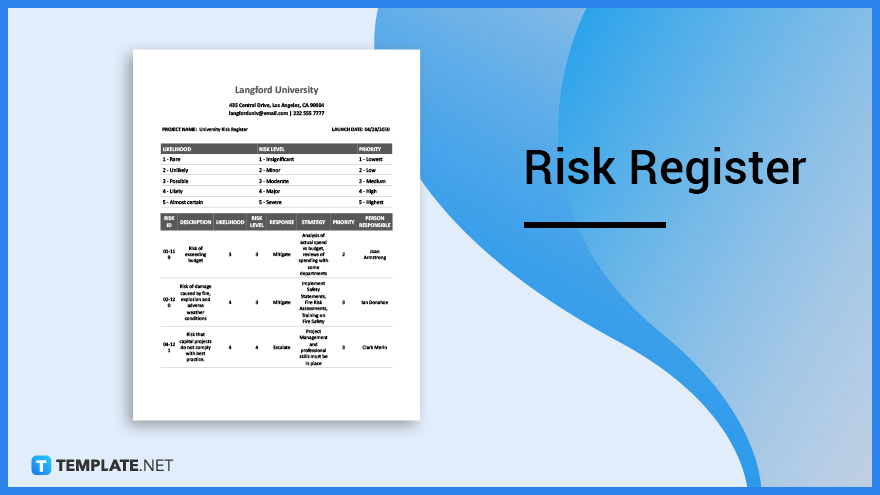
Download the Risk Register Article in PDF
File Format:
Risk Register Definition & Meaning
A risk register is a management tool project managers use to monitor and track any potential risks within an organization or a project.
Organizations use the document to fulfill regulatory compliance requirements and be ahead of potential issues and problems that can affect the intended outcomes of events and processes.
What Is a Risk Register?
A risk register is a document businesses use as a risk management tool to identify the possible lapses within a project, incorporating the processes intending to identify, analyze, and solve possible risks in the system before they become problems. The risk register document, also known as risk register logs, are records that track potential risks in a project, classifying them, including priority and likelihood of occurrence. The document must not only identify and classify the category of a risk, but it must also provide mitigation plans and measures for team members to prepare viable solutions and guidelines to solve the issues.
10 Types of Risk Register
Business Risk Register
A business risk register is a document that contains a list of identified risks, including the likelihood and consequences of these risks occurring and the practical safety actions to take to reduce the risks, including the person or persons responsible for managing them. A business risk register is a central repository that lists all possible risks associated with the operations and opening of a business or launching specific projects. The document serves as a risk management tool, essential for business operations that project and business managers use.
University Risk Register
A university risk register is a management tool that a university uses to support the risk framework capturing the strategic institutional risks in an institution. It is a comprehensive document containing detailed descriptions of a university’s risk factors, including collections of strategies that the university has in place to mitigate each identified risk. A university envisions the register as a living document for planning processes and improving decision-making procedures for university projects and activities.
Security Risk Register
A security risk register is a business document to focus on supporting an organization’s cybersecurity and information security management programs with the supervision of security teams. These risk owners are responsible for creating an inventory of potential security risk events and identifying the likelihood, impact, and description of these events to track risky scenarios. In making these risk registers, there must be a separate record to log control deficiencies as they can be contributors to the risk already identified in the register.
Quality Risk Register
A quality risk register is a document businesses use as a risk management tool to identify, analyze, and solve risks under standardized protocols and regulations from international organizations. These quality risk registers are prevalent in regulated industries like pharmaceuticals to ensure that their products and services meet prescribed standards from governing bodies and industry professionals. Companies must store these records for risk analysis processes to produce viable solutions to address early warning signs of imminent risks.
School Risk Register
School risk registers are organizational documents that enable management, board, and executives to track, monitor, and plan for risk and risk controls within the educational institution affecting the school or trust. The pressure of identifying risks and incorporating them into the register falls into the management team’s responsibility as these events or scenarios impact an organization’s financial, operational, and strategic aims. The purpose of creating the register is to analyze and identify possible risks, aiding the management team in developing risk incident plans and disaster plans.
Health and Safety Risk Register
A health and safety risk register focuses on identifying risks and hazards in a specific area, including its risk level and controls, and implementing minimizing or eliminating the risks associated with identified hazards. A risk register is a tool for guiding health and safety executives and teams to develop risk profiles detailing all high-level risks, existing control systems, and additional controls and actions an organization requires. Through the register, a company can devise a structure that helps in the decision-making process of how to treat, manage, and monitor identified risks.
Supply Chain Risk Register
Public and private companies undoubtedly have problems when it comes to their supply chains, and more often than not, there are still problems that significantly impact various organizations because of risks that are left unmanaged and unresolved. Many businesses still struggle to progress and develop their supply chain management due to the low probability of transparency, intimidating levels and scopes of risks, and proprietary data restrictions. Constructing a supply chain risk register allows companies and agencies to identify, manage, and mitigate risks, measuring and managing them over time.
Hospital Risk Register
Hospitals are institutions that require management, executives, and professionals to make accurate and timely decisions due to the nature of the work setting, and the parallel of saving lives hangs in the balance and the hands of field experts. Developing a hospital risk register is vital to the organization as it contains a list of all the identified risks during periodical hospital reviews, making it a critical document to communicate the status of known risks that the management uses for management control, checklists, reports, and reviews. The document incorporates the risks that individuals identify during risk identification workshops from hospital units, divisions, and functions.
Event Risk Register
Risks are inherent in any location and every activity that individuals and groups engage in, no matter how organizers set up and plan events, and event organizers must learn to identify, analyze, assess, control, minimize, and eliminate risks. Various risks happen during events, including delayed show times, audience injuries, system failures, and even natural disasters from weather events. Taking notes on these occurrences helps an organizer develop a comprehensive event risk register, identifying possible risks before they can turn into unsolvable problems that can ruin the entirety of an event.
Financial Risk Register
A business’ finances are necessary aspects that make an organization run smoothly, and it is there to ensure that there are enough funds and financial resources to operate and that it uses the fund to purchase and invest wisely. However, there are still instances wherein a business faces financial problems too late to prevent and remedy, making the finance and accounting teams suffer criticism and resentment. Developing a financial risk register enables the financing department to identify and analyze potential risks and formulate necessary solutions to ensure that the risks do not negatively impact the organization or project.
Risk Register Uses, Purpose, Importance
Risk registers are necessary to prevent multiple risks that can arise in a given scenario, and no team or organization will want to suffer the consequences of events. As such, organizations, agencies, groups, and departments must develop a risk register to aid them in identifying and addressing possible problems.
Strengthen Data Security
By establishing risk registers for an organization or a specific project, team members can track and mitigate possible risks from manifesting. Setting up the document enables a business or department to prevent general and classified information from being stolen, and any data breaches can lead to loss of revenue or legal consequences. Data security is a top risk that results in long-term security issues, and businesses must find ways to mitigate them before they become a problem is a priority for risk registers.
Prevent Communication Issues
Communication is a priority for organizations to function effectively and efficiently, and issues can arise no matter the size of the project. Risk registers can help teams identify the communication areas of a project, implement work management software, and streamline work communication. Risk registers also enable the project team or business departments to formulate communication plans to prevent risk from manifesting.
Stop Schedule Delays
Schedule delays that go unnoticed cause massive problems for project managers and team members, especially if it results in missing deadlines. Risk registers can pinpoint the cause of delays and make solutions for them before they happen. Schedule delays lead to confusion and rushing of deliverables that the project suffers quality requirements, and the use of calendar software helps the team stay on track after the project team manager notes the risk of schedule delays.
Discourage Unplanned Workloads
Risk registers can identify and analyze situations wherein workers or team members go over project scope and objectives. Risk registers can mitigate these instances if and when project managers use the tool to track roles and responsibilities efficiently. Pinpointing these unplanned activities and tasks enables managers to delegate work appropriately.
Prevent Inventory Errors
Whether it is the theft of materials due to a high volume of supply in company storage or an error in recording inventory, risk registers help mitigate these risks in companies. Tracking inventory consistently and frequently prevents these risks from happening, pinpointing them earlier on, and finding the necessary solutions to address them. Without risk registers, a business has exposure to revenue loss, uncertainty, and time misuse.
What’s in a Risk Register? Parts?
Risk Identification
One of the primary components of a risk register, the section provides risk identification. The risk identification section must consist of the risk name, identification date, and a subtitle, as necessary.
Risk Description
The next portion of the risk register must include a short description, indicating a brief or high-level overview and the reason for the risk becoming a potential issue. The average length of a risk description ranges from 80 to 100 words to accurately describe the risk.
Risk Category
Risk categories allow individuals to identify the risks, making it easier to account for each one, especially during complex projects. Risk categories focus on operations, budget, schedule, inventory, quality, etc.
Risk Likelihood
Risk likelihood allows management teams to identify, sort, and flag risk before taking action. Project managers can document risk likelihood by sorting them according to which to tackle first.
Risk Analysis
The risk analysis section estimates the impact of a risk on a project or organization, identifying the most significant risk to handle first. Project managers sort this according to a five-point scale together with department heads.
Risk Mitigation
The risk mitigation section consists of a plan known as a risk response plan, one of the most crucial components of a risk register. The risk mitigation plan must include a step-by-step solution to lessen the impact of a risk, a brief description of the intended outcome, and how the plan affects its impact.
Risk Prioritization
This section of the risk register accounts for the likelihood and the risk analysis. The risk prioritization makes it clear which of the identified risks can have dire consequences on a project.
Risk Ownership
After identifying, analyzing, and prioritizing risks, project managers assign an individual or group accountable for monitoring them. Incorporating this section in the risk register contents makes it easier to identify the departments responsible for them.
Risk Status
The last section of a risk register is the risk status, stating whether there is successful mitigation of the risk. Project managers fill in the section of the risk status with open, in progress, or closed.

How To Design A Risk Register?
1. Determine the risk register size.
2. Specify the purpose of creating the risk register.
3. Pick the risk register templates.
4. Identify the risks.
5. Provide risk descriptions.
6. Estimate the impact of risk.
7. Develop a risk response plan.
8. Prioritize risks.
9. Identify risk owners.
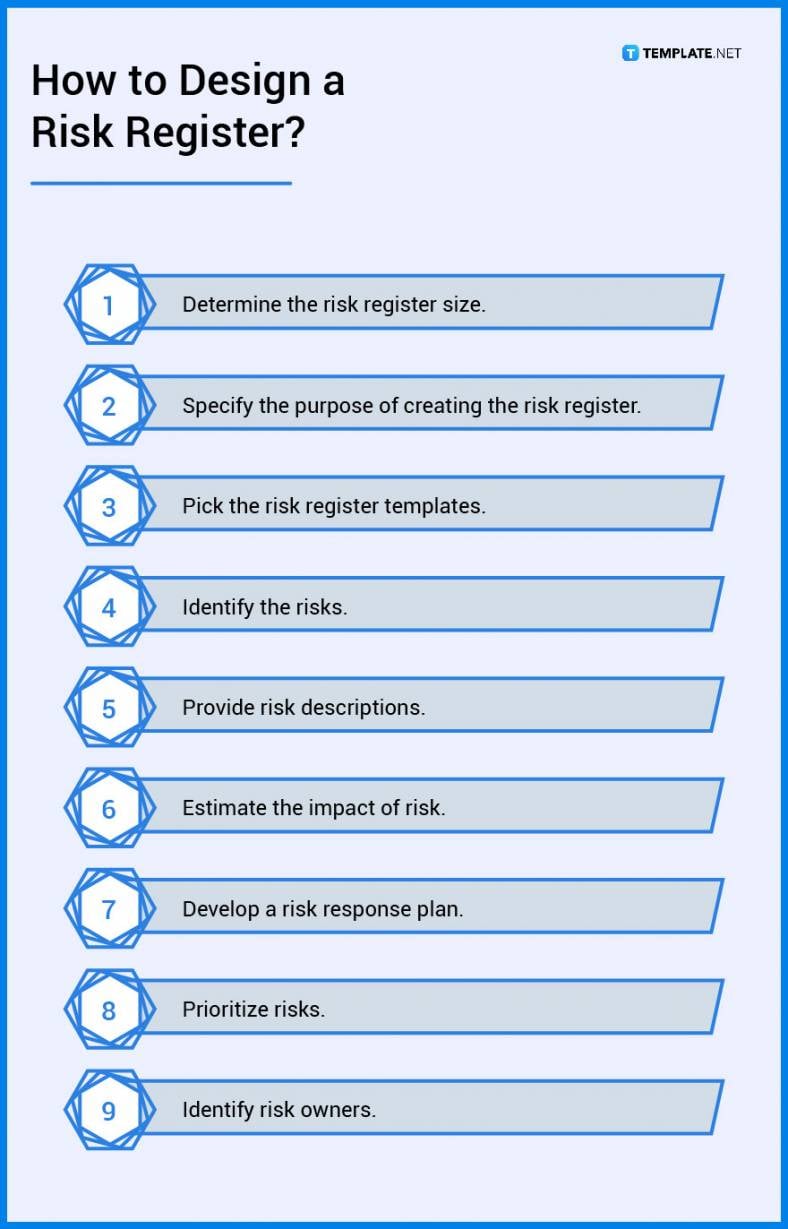
Risk Register vs. Risk Assessment
Risk registers are management tools organizations use to list identified risks and additional information about each risk that teams and departments identify.
Risk assessment is a process of identifying, evaluating, prioritizing risks, and analyzing the possible outcomes if a risk occurs.
What’s the Difference Between Risk Register, Matrix, and Report?
Risk registers are business document logs organizations use to identify project risks that project managers use for risk management planning.
A risk matrix is a document matrix that assists risk assessments in identifying the risk probability, impact, urgency, and category.
A risk report is a business document incorporating comprehensive and understandable information about risks and their strategic and financial impacts, producing copies for stakeholders.
Risk Register Sizes
Risk registers are vital documents for organizations implementing various projects throughout the year, identifying the potential risks that can happen during the project timeframe and addressing them. Construct the risk register using standardized risk register sizes for record-keeping and documentation purposes.
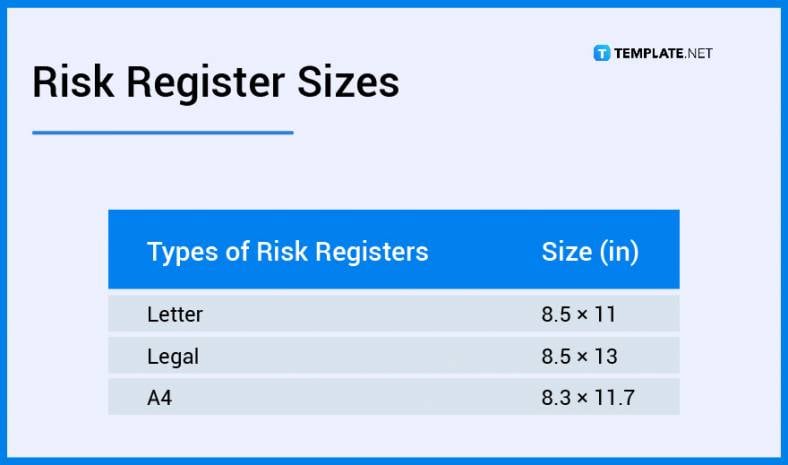
Risk Register Ideas & Examples
Risk registers are present in various departments and organizations, targeting specific projects that a company implements, ranging from construction, finance, security, etc. There are different risk register ideas and examples that organizations can select from, starting from our list below.
- Risk Register Ideas and Examples
- Operational Risk Register Ideas and Examples
- Project Risk Register Ideas and Examples
- Internal Audit Risk Register Ideas and Examples
- IT Project Risk Register Ideas and Examples
- Hazard Risk Register Ideas and Examples
- Data Protection Risk Register Ideas and Examples
- Information Security Risk Register Ideas and Examples
- Corporate Risk Register Ideas and Examples
- Building Risk Register Ideas and Examples
- Charity Risk Register Ideas and Examples
FAQs
What is a risk register in healthcare?
Healthcare risk registers are documents comprising a list of risks in healthcare institutions and the necessary information about them.
How do you maintain a risk register?
Management must manage risks strategically, focus on the areas with limited resources, and secure additional resources to understand the value of preventive risk measures to maintain risk registers.
Who is responsible for the risk register?
A project manager is responsible for updating and maintaining a risk register of a project.
What is included in a risk register?
A risk register includes several components, including risk identification, risk description, risk category, risk likelihood, risk analysis, risk mitigation, risk prioritization, risk ownership, and risk status.
How do you review a risk register?
Risk reviews focus on identifying and documenting actions or events that bring change to the risk status.
What is the risk register in a hospital?
A hospital risk register is a document that identifies risks during periodic hospital reviews, communicating the status of known risks for management control.
What should be in a risk register?
The contents of a risk register must include risk identification, risk description, risk category, risk likelihood, risk analysis, risk mitigation, risk prioritization, risk ownership, and risk status.
What is a strategic risk register?
A strategic risk register or SRR identifies corporate risks concerning corporate and service plans specified by management that can impact the organization’s implementation of strategic goals and objectives.
What is the risk owner responsible for?
A risk owner is responsible for identifying, assessing, managing, and monitoring risks.
How do you write a risk register?
To write a comprehensive risk register, a project manager must first identify and analyze possible risks, create response plans for each risk, and assign the risk owners.





